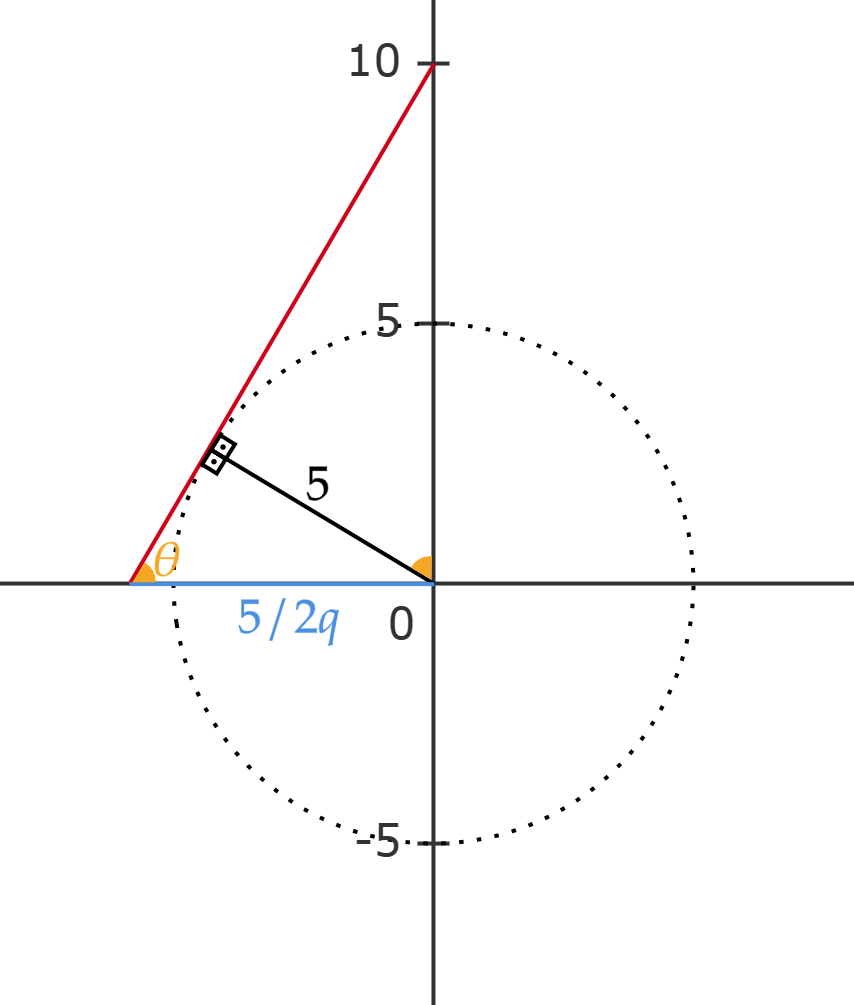Considere as retas em que os coeficientes , em ordem crescente de , formam uma progressão aritmética de razão . Se e a reta tangencia a circunferência de equação , determine o valor de .
CossenoGPT
Teste
gratuitamente agora
mesmo! 

Conforme enunciado, pode-se escrever para a reta tangente a circunferência:\begin{matrix}
r_5: & y = (4q)x + 10
\end{matrix}$• \ \text{Resolução I:}$ $\color{#3368b8}{\text{Geometria}}$
Conhecida a equação da circunferência, assim como a reta em questão, é possível esboçar:
 Veja que $\theta$ é um ângulo notável, dado que:\begin{matrix}
\cos{\theta} = \dfrac{5}{5+5} &\Rightarrow&\cos{\theta} = \dfrac{1}{2} &\therefore& \theta = 60º
\end{matrix}Em posse desse resultado, segue:\begin{matrix}
\sin{\theta} = \dfrac{5}{5/2q} &\Rightarrow& \dfrac{\sqrt{3}}{2} = 2q &\therefore& q = \dfrac{\sqrt{3}}{4} & \tiny{\blacksquare}
\end{matrix}$• \ \text{Resolução II:}$ $\color{#3368b8}{\text{Álgebra}}$
Conhecida a equação da reta, pode-se substituir a mesma na equação da circunferência a fim de encontrar o ponto de tangência, veja:\begin{matrix}
x^2 + (4qx + 10)^2 = 25
\end{matrix}Então,\begin{matrix}
(16q^2 + 1)x^2 + (80q)x + 75 = 0
\end{matrix}Como se trata de um ponto de tangência, o discriminante deve ser nulo, isto é:\begin{matrix}\Delta = (80q)^2 - 4 \cdot (16q^2 + 1) \cdot 75 = 0
\end{matrix}Assim, \begin{matrix}1600q^2 = 75(16q^2 + 1)
\end{matrix}Portanto,\begin{matrix}
q = \dfrac{\sqrt{3}}{4} & \tiny{\blacksquare}
\end{matrix}
Veja que $\theta$ é um ângulo notável, dado que:\begin{matrix}
\cos{\theta} = \dfrac{5}{5+5} &\Rightarrow&\cos{\theta} = \dfrac{1}{2} &\therefore& \theta = 60º
\end{matrix}Em posse desse resultado, segue:\begin{matrix}
\sin{\theta} = \dfrac{5}{5/2q} &\Rightarrow& \dfrac{\sqrt{3}}{2} = 2q &\therefore& q = \dfrac{\sqrt{3}}{4} & \tiny{\blacksquare}
\end{matrix}$• \ \text{Resolução II:}$ $\color{#3368b8}{\text{Álgebra}}$
Conhecida a equação da reta, pode-se substituir a mesma na equação da circunferência a fim de encontrar o ponto de tangência, veja:\begin{matrix}
x^2 + (4qx + 10)^2 = 25
\end{matrix}Então,\begin{matrix}
(16q^2 + 1)x^2 + (80q)x + 75 = 0
\end{matrix}Como se trata de um ponto de tangência, o discriminante deve ser nulo, isto é:\begin{matrix}\Delta = (80q)^2 - 4 \cdot (16q^2 + 1) \cdot 75 = 0
\end{matrix}Assim, \begin{matrix}1600q^2 = 75(16q^2 + 1)
\end{matrix}Portanto,\begin{matrix}
q = \dfrac{\sqrt{3}}{4} & \tiny{\blacksquare}
\end{matrix}

Ampliar Imagem

